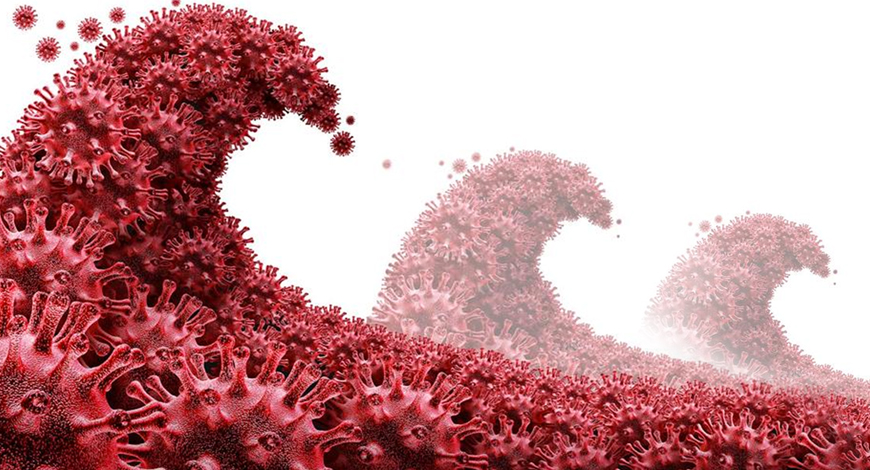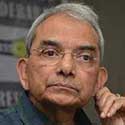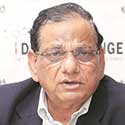MB Stories
India is not out of the woods yet

The increased presence of the Delta variant and the subsequent mutations of the coronavirus make the third wave imminent and inevitable. The number of daily new cases seem to have plateaued and the decline in active cases has started narrowing. The discussion now revolves around the timing and the intensity versus the second wave that was an absolute disaster for more reasons than one.
A recently released report by Tanvee Gupta-Jain, chief economist at UBS Securities India, maintains that in over 20 percent of the topic caseload districts, where the second wave has ebbed, the third wave has already set in firmly. This compares to only 5 percent a month
ago.
Lav Agarwal, Joint Secretary, Ministry of Health and Family Welfare, dissents with, the COVID-19 pandemic is still amidst us and even in limited geography, we are still battling the second wave. There are 47 districts in the country across 12 states and UTs, Manipur, Kerala, Rajasthan, Meghalaya, Mizoram, Arunachal Pradesh, Nagaland, Sikkim, Tripura, Assam, Maharashtra and Puducherry, where the positivity rate is more than 10 percent. Further, 73 districts are reporting more than 100 daily cases.
Low vaccination rates are the prime culprit. India must inoculate at least 60 percent of its 1.3 billion population with both doses of a COVID-19 vaccine to guard against a third wave. To achieve this threshold, she must daily administer vaccines to 8.6 million people as against the current average of 3.9 million. At the current pace, India will be able to vaccinate 45 percent of its adult population by year-end and 60 percent by the end of March 2022. And for each day that India fails to reach its daily vaccination target, the required rate continues to increase.
 Three sets of estimates for average monthly production by Minister of State for Health and Family Welfare Dr Bharati Pravin Pawar are floating around – July 20, 2021
Three sets of estimates for average monthly production by Minister of State for Health and Family Welfare Dr Bharati Pravin Pawar are floating around – July 20, 2021
Reply to Congress MP Mallikarjun Kharge in the Rajya Sabha
Covishield-11 crore doses
Covaxin-2.5 crore doses
Reply to BJP MP TG Venkatesh’s question
Covishield-13 crore doses
Covaxin-1.75 crore doses
Comment on MoUs signed between ICMR and Bharat Biotech
Covaxin production to be enhanced to 10 crore doses
As of July 19, 411.35 million doses were administered. Despite halting all exports in April and benefiting from a domestic vaccine-producing industry, India has covered only 4 percent of its vast population, putting it far behind most of the West and China, which is deploying about 20 million doses a day. Indian authorities have set themselves a target of vaccinating 10 million people a day, India’s challenges in accelerating its inoculation drive are considerable.
The average monthly production capacity of Covishield by Serum Institute of India is 110 million doses, and of Covaxin by Bharat Biotech is 25 million doses. The government has received 360 million doses of Covishield and 54.5 million doses of Covaxin up to July 16. Increased production capacity is planned. SII expects that Covishield production will go up to more than 120 million doses per month, while Covaxin expects production to increase to 58 million doses per month. Covaxin is yet to receive its pre-qualification approval for an Emergency Use Listing from WHO, it is expected by end August.
 “Analysis of the daily death load metrics shows the signs of the onset of a third wave of COVID-19 since July 4. The third wave in India has already arrived.” Vipin Srivastava, Former Pro-Vice-Chancellor, University of Hyderabad
“Analysis of the daily death load metrics shows the signs of the onset of a third wave of COVID-19 since July 4. The third wave in India has already arrived.” Vipin Srivastava, Former Pro-Vice-Chancellor, University of Hyderabad
In its affidavit to the Supreme Court submitted last week of June 2021, the government revised its figures for vaccine supply before the end of this calendar year. Earlier, in May, Union Health Minister Harsh Vardhan, in an official briefing, had said that 2.1 billion vaccine doses would be made available between August and December 2021. In this latest affidavit, however, the government has committed to only 1.35 billion. The first figure from Vardhan included some optimistic projections for as yet untested vaccines as Gennova’s mRNA nasal vaccine from Bharat Biotech, and the Supreme Court affidavit does not include these. But both include figures for a vaccine candidate from Zydus Cadila, which has not been approved yet, so the basis for inclusion or exclusion is not clear. Nor is this exclusion of some vaccines the only difference. The new projections suggest 250 million fewer doses of the Serum Institute’s Covishield will be available.
The affidavit’s projection for the number of vaccines required for every adult in India – just under 1.9 billion – is almost exactly the same as the affidavit’s projection for the number of vaccines that will be made available by then, if 516 million doses produced by July 31 are added to the 1.35 billion between August and December.
There are other questions raised by the affidavit. For one, the 400 million doses of Bharat Biotech’s Covaxin being promised between August and December have to reckon with other figures in the affidavit that suggest that only 28 million doses of the vaccine had been supplied till June 12, against the order of about 80 million doses. How Bharat Biotech will increase production so quickly needs consideration.
A total of 3.3 million doses of Sputnik V were imported till July 14 and 0.261 million doses of Sputnik V administered. India plans to produce 850 million doses of Sputnik V. The issue of difference in the first and second dose composition of the vaccine remains. Unlike Covishield and Covaxin, Sputnik V second dose cannot be administered from the same vial. The gap between the two doses is 21 days. Dr Reddy’s Laboratories, is the distributor of the Russian COVID-19 vaccine.
 “The present situation in India is under control. But India is far from achieving herd immunity through vaccination. Hence, the risk remains. The next few months will be very crucial.” VK Paul, Member (Health), NITI Aayog
“The present situation in India is under control. But India is far from achieving herd immunity through vaccination. Hence, the risk remains. The next few months will be very crucial.” VK Paul, Member (Health), NITI Aayog
Dialogue is on to make available 7.5 million doses of Moderna vaccine, to be imported by Cipla, through COVID-19 Vaccines Global Access (COVAX) programme. This is subject to clearance of the indemnity clause, similar to Pfizer and Johnson & Johnson.
Four COVID-19 vaccine candidates are at different stages of human trials while one, developed by Genique Life Sciences, is in the advanced pre-clinical stage. Cadila Healthcare Ltd.’s DNA-based vaccine candidate is in Phase-III clinical trial. It has also submitted the interim data for emergency use authorisation. Biological E Ltd.’s vaccine candidate is also in Phase-III clinical trial. Bharat Biotech International Ltd.’s Adeno intranasal vaccine candidate is in Phase-III clinical trial, while Gennova Biopharmaceuticals Ltd’s mRNA-vaccine candidate is in Phase-I clinical trial.
There is also considerable hesitancy to overcome and logistical hurdles to reaching much of the countryside, where more than two-thirds of Indians live.
The acute shortage of doctors, nurses, and skilled technicians continues to hound the country. India has 1.16 million doctors, of whom only 80 percent, or 0.9 million, are working. This translates into 0.68 doctors for every 1000 people. The WHO prescribes a ratio of 1:1000. Keeping in mind, those graduating with an MBBS degree every year, it will take India 10 years to reach the WHO standard. Other partners at BRICS (Brazil, Russia China, and South Africa) average two doctors for every 1000 people. The Organisation for Economic Co-operation and Development (OECD) has 3.1 doctors. At the current pace, India will take 32 years and 57 years to level with BRICS and OECD, respectively.
There are not enough nurses, either. WHO prescribes three nurses per 1000 people; India last year had 3.24 million or 2.36 nurses per 1000 people. As the country adds 0.21 nurses every year, it would take two years to reach the WHO-required nurse ratio, 11 years to reach BRICS and 32 years to get to the OECD ratio of 9.6 nurses per 1000 people.
 “It is likely that India will see almost 100,000 cases every single day with the onset of the third wave of the viral infection in August, sometime toward the end. In the current situation, if the virus doesn’t mutate to lead to more transmissibility, the situation will be similar to the first wave. And if the virus mutates further, then the situation could be worse.” Samiran Panda, Director & Scientist-G NARI/ICMR and co-researcher of a study done by ICMR with Imperial College, London
“It is likely that India will see almost 100,000 cases every single day with the onset of the third wave of the viral infection in August, sometime toward the end. In the current situation, if the virus doesn’t mutate to lead to more transmissibility, the situation will be similar to the first wave. And if the virus mutates further, then the situation could be worse.” Samiran Panda, Director & Scientist-G NARI/ICMR and co-researcher of a study done by ICMR with Imperial College, London
India as of now is producing enough oxygen for medical purposes. A total allocation of 10,250 MT (metric tonnes) had been made to 26 high-burden states as on May 28, 2021 and 1222 PSA plants sanctioned under the PM-Cares fund.
The sudden surge of COVID infections and the subsequent need for supplemental oxygen in late March blindsided India’s healthcare network. The daily demand for medical oxygen, spiked to 12 times pre-COVID levels. Ordinarily, India produces 9000 tons of liquid oxygen each day. Only 10 percent to 15 percent of that goes toward medical supplies. The rest is used in industry, such as steelmaking. In late April, the government banned the use of liquid oxygen for industrial purposes, with a few exceptions. Since the government order was issued, oxygen that is typically used for industry has fulfilled around 80 percent of the medical oxygen demand. The rest is being met by oxygen generation plants at hospitals, small generation plants that supply oxygen cylinders to hospitals, and imports.
Manufacturers as Reliance Industries, ITC, Inox Air Products, Linde India, among others, had responded with enhanced production capacities, expanded tanker truck fleet by repurposing tanker trucks that normally carry nitrogen and argon, established railway systems, and other similar initiatives.
In the recent major shuffling of ministers on July 7, Mansukh Mandaviya replaced Dr Harsh Vardhan as the health minister, who promptly, from the union cabinet, received ₹23,123 crore (₹15,000 crore to be spent by the Center and the balance by the states) emergency response package to boost public healthcare facilities by March 31, 2022 to combat the expected third wave. The Cabinet had allocated ₹15,000 crore as the first phase of COVID-19 emergency relief package in April 2020, and this was the second tranche.
 “We have created three scenarios. One is the optimistic one. In this, we assume that life goes back to normal by August, and there is no new mutant. Second is the intermediate one. In this we assume that vaccination is 20 percent less effective in addition to optimistic scenario assumptions. Third is the pessimistic one. This has one assumption different from intermediate one: a new, 25 percent more infectious mutant spreads in August.” Manindra Agarwal, Professor, IIT Kanpur
“We have created three scenarios. One is the optimistic one. In this, we assume that life goes back to normal by August, and there is no new mutant. Second is the intermediate one. In this we assume that vaccination is 20 percent less effective in addition to optimistic scenario assumptions. Third is the pessimistic one. This has one assumption different from intermediate one: a new, 25 percent more infectious mutant spreads in August.” Manindra Agarwal, Professor, IIT Kanpur
The allocation will put in place a loan scheme, based on government guarantees, for the private sector to augment existing hospital capacity and create new facilities. The new plan envisages a credit guarantee scheme for private hospitals in cities other than the eight metros. This signals a healthy public-private partnership. India needs human capital, financial capital, and management. And all three are scarce in the government sector. Given that the private sector accounts for more than 70 percent of India’s healthcare market, a public-private partnership should drive the expansion of access to healthcare.
A key element of the strategy is to fund augmentation of human resource capability, with the help of medical and nursing students. The second wave had proved how vital the frontline workers are in combating the virus.
The finer details show that in the over 100 aspirational districts, 75 percent guarantee cover will be available for both new projects as well as expansion. Hospitals would now be eligible for loans up to ₹100 crore, with interest rate capped at 7.95 percent. This is the latest move to boost health facilities with the Reserve Bank of India having opened a special ₹50,000 crore window for the sector.
While it is all speculation whether the third wave affects children more or with increased severity, and new variant weakens existing vaccines, what is certain is that the third wave is slowly beginning across the globe. The number of cases has been rising in countries, such as Indonesia and Columbia. It will require explicit policy controls, COVID appropriate behavior, sequencing to keep eye on mutations, and much, much more for India to delay and limit its impact. It would be nothing short of a miracle if she escapes it altogether.












